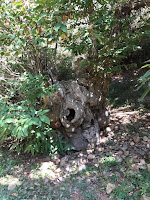As a soft-fleshed and lazy person I view them partly with admiration and wonder, and partly with fear and horror. It is an unimaginably long time since they arrived. Some are obviously made of layer upon layer of sediment, once presumably quite level and soft, but then hardened and later bent up into tormented and tortuous folds and bends - the seabed literally lifted to the heavens, to be worn down again and the tiny gritty particles of dust to settle once again on a sea bed somewhere... The process begins again. Some of these rocks look as soft as butter. Then you touch them, and find they are the hardest substance you have ever touched. The volcanic 'toffee' in the huge crater of Mount Teide in Tenerife is like that.
It is in these uplifts that people have searched for and found things of value. For instance, they have found distance - the chance of seeing a very long way, which might give them warning of the approach of an enemy, or the sense of ownership of the territory spread out below them, or an understanding of how the land lies, or maybe the chance to connect with the Great Powers of the Universe - the starry skies, the blue heaven, storms.
Having bid farewell to Galicia yesterday morning, we headed east and into these mountains - and eventually to the extraordinary sky-village now called O Cebreira. It is not well signposted, and it is very very high up. It was settled well over two thousand years ago, with round stone houses, thatched and snug, and in use till a few years ago. Then as decline and modern ways set in (just as in Perithia, in Corfu, where we were just a few weeks ago), the houses were in danger of being lost completely, and it was the parish priest who organised to save them. Nine survive, four still inhabited, the rest in use as museums or storage spaces.
Actually the locals seem to like round things, as the church gate posts are round, the buttresses on various walls are round, door-jambs are round, even a cupboard carved from one solid tree has a round interior though the back and sides are squared off. There is said to be a Holy Grail in the little church (sadly not a round building, and locked when we were there). The place is thronged with pilgrims and tourists and is - well, exciting. The views all around are stupendous. A magic place, lived in since long before the Romans arrived. Round houses are associated with matriarchy, and quite right too.
But of course, it is not only distance which people value in the mountains. They have also found metals - copper, lead, silver, gold.... And a little further on, in a golden land of vineyards and quaint crooked villages with massive jettied balconies, we came across the biggest ancient goldmine of antiquity. Asturia is where the Romans got all their gold. Since 80% of all gold now in use has been mined in the last 200 years, there was clearly much less around two thousand years ago, and its value was commensurately higher. It was fantastically difficult to get. Even for the Romans, the journey to be made from Rome to this distant edge of Iberia was a long one, and presumably the engineers, miners, soldiers, directors, financiers and so on all had to get to it. The place is now called Las Meduras, and it's truly weird.
What they had to do was to get down more than 100m into the rock to find the layers with traces of gold in them. They knew it was there because the locals had been panning it in the rivers for generations, but that wasn't enough for the Romans. So they decided to remove the top layers of rock. They used water, and channelled it into cracks. They used the water to make 'explosive' air pressure further down. They used fire to heat the rocks and then cold water to create steam. They dug tunnels and pits and deep trenches, and basically they removed whole mountains. The peaks left behind are a bright burning red colour - again hard enough to touch - and these stand out like ridiculously pointy needles and slabs. There are massive cliffs where their operations ceased, but which give testimony to how much spoil was removed. This process was called 'ruining mountains' - ruina monteum. Pliny the Elder wrote about it in 77BC, mentioning how dangerous it was. The labour force - so they say - was of free men, not slaves. 60,000 of them. But how do we know? Some of them lived down in the tunnels for months, never seeing daylight. They had to be fed, watered. And the area of operations is massive - really spreading for miles around. They carried on doing this for 250 years and although it is debatable, Pliny said 20,000 Roman pounds of gold were extracted each year. (A Roman pound is aproximately 11-12 oz). Another estimate is that 1,650,000 kilograms of gold was taken. Astonishing. The resulting landscape is just breath-taking - red, torn, secret, difficult, silent.
The land around is now used for growing sweet chestnuts, and these trees are themselves described as centurions, being massive and ancient. They have been pollarded over and over again, and their trunks are huge and contorted. They all have wildly expressive markings on them - like some silent opera. There are signs up everywhere warning you not to steal the chestnuts. The walks around the area are open and free and well maintained. On a late summer afternoon, you almost have the place to yourself.













Always such a lovely read. Thanks G.
ReplyDelete